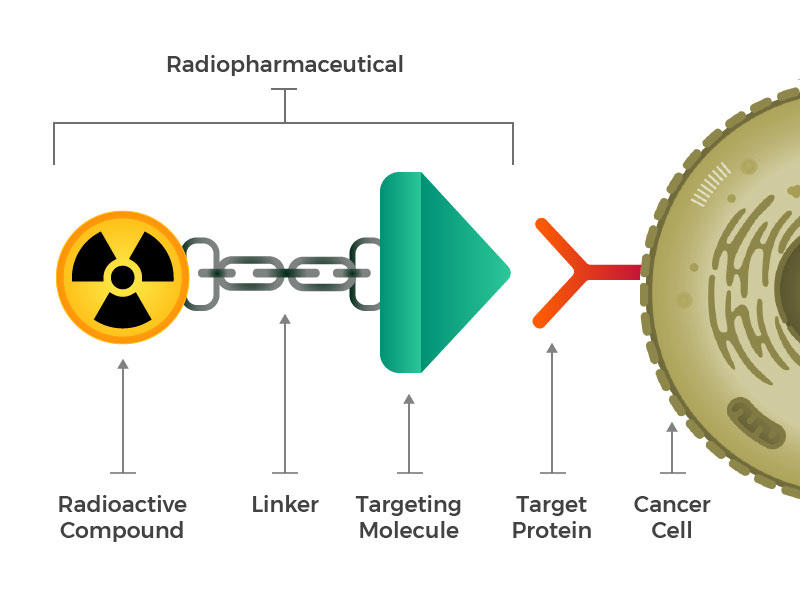Introduction
Radiopharmaceuticals are an integral part of modern nuclear medicine, a field that has significantly advanced our ability to diagnose and treat a wide range of medical conditions. These specialized pharmaceuticals contain small amounts of radioactive isotopes, which emit radiation that can be detected and used for various medical applications. In this blog post, we’ll explore the world of radiopharmaceuticals, their applications in nuclear medicine, and the science behind their use.
What Are Radiopharmaceuticals?
Radiopharmaceuticals, often referred to as radiotracers, are drugs that contain a radioactive substance. These substances can be injected, swallowed, or inhaled, and they emit gamma rays, which are a type of ionizing radiation. This radiation is used in nuclear medicine for diagnostic imaging and therapeutic purposes. Radiopharmaceuticals are designed to target specific organs, tissues, or cells within the body, allowing for precise medical imaging and treatment.
Applications of Radiopharmaceuticals
Radiopharmaceuticals find applications in a variety of medical fields, including:
Diagnostic Imaging: One of the most common uses of radiopharmaceuticals is in diagnostic imaging. By injecting a patient with a radiopharmaceutical, healthcare professionals can obtain images of the inside of the body. This is particularly useful for detecting abnormalities, such as tumors, in various organs. Common diagnostic procedures include positron emission tomography (PET) and single-photon emission computed tomography (SPECT).
Thyroid Disorders: Radioactive iodine is often used to diagnose and treat thyroid disorders. It is administered in controlled doses to target and destroy overactive thyroid tissue or thyroid cancer cells.
Cardiovascular Imaging: Radiopharmaceuticals can be used to assess blood flow to the heart muscle, helping diagnose and manage heart conditions. This is done through procedures like myocardial perfusion imaging.
Cancer Treatment: In some cases, radiopharmaceuticals are used for targeted radiation therapy, known as radioimmunotherapy. This approach delivers radiation directly to cancer cells, minimizing damage to healthy tissue.
Bone Scans: Radiopharmaceuticals are utilized for bone scans to detect bone disorders, fractures, and bone metastases from cancer.
The Science Behind Radiopharmaceuticals
The effectiveness of radiopharmaceuticals lies in their ability to emit gamma rays, which can be detected by specialized imaging devices. The radioactive isotopes used in radiopharmaceuticals decay over time, emitting radiation in the form of gamma rays. The type and energy of these gamma rays provide crucial information about the location and function of specific organs or tissues.
Commonly used radioactive isotopes in radiopharmaceuticals include:
Technetium-99m: This isotope is widely used in diagnostic imaging due to its relatively short half-life and ease of handling.
Iodine-131: Used in the diagnosis and treatment of thyroid disorders.
Fluorine-18: Employed in PET scans, particularly for cancer diagnosis.
Gallium-67: Useful in imaging for infections and certain types of cancer.
The choice of isotope and its incorporation into a radiopharmaceutical is carefully considered to match the specific diagnostic or therapeutic need.
Safety Considerations
The use of radiopharmaceuticals requires careful handling and precise dosing to ensure patient safety. Healthcare professionals who work with these substances are trained to minimize radiation exposure. Additionally, there are strict regulations and guidelines in place to govern the use and disposal of radiopharmaceuticals to protect both patients and healthcare providers.
Benefits and Limitations
Radiopharmaceuticals offer several advantages in the field of nuclear medicine:
Non-Invasive: Radiopharmaceutical procedures are typically non-invasive, meaning they do not require surgical incisions. This reduces patient discomfort and the risk of infection.
Precise Imaging: These pharmaceuticals enable highly precise imaging of internal structures, allowing for early disease detection and accurate diagnosis.
Targeted Therapy: In the case of radioimmunotherapy, radiopharmaceuticals can be precisely targeted to cancer cells, minimizing damage to healthy tissue.
Therapeutic Potential: Some radiopharmaceuticals can not only diagnose but also treat medical conditions, such as hyperthyroidism or certain cancers.
Despite their numerous benefits, radiopharmaceuticals do have limitations. They have a limited shelf life due to the radioactive decay of the isotopes. Additionally, the production and handling of these substances require specialized equipment and expertise, making them relatively costly.
Conclusion
Radiopharmaceuticals have transformed the world of nuclear medicine, offering a non-invasive and highly effective means of diagnosing and treating various medical conditions. From detecting cancer and heart diseases to managing thyroid disorders, these innovative pharmaceuticals continue to play a pivotal role in modern healthcare. As technology advances and our understanding of radioisotopes deepens, the applications of radiopharmaceuticals are likely to expand, providing even more precise and effective medical solutions.


